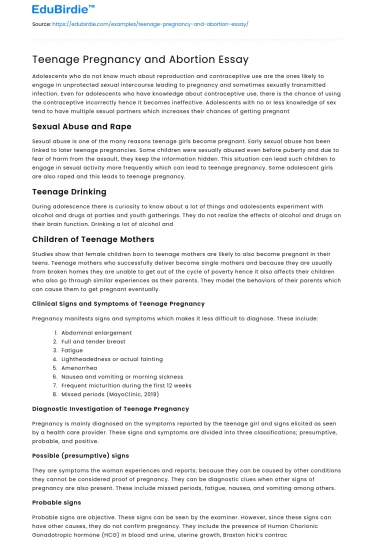Adolescents who do not know much about reproduction and contraceptive use are the ones likely to engage in unprotected sexual intercourse leading to pregnancy and sometimes sexually transmitted infection. Even for adolescents who have knowledge about contraceptive use, there is the chance of using the contraceptive incorrectly hence it becomes ineffective. Adolescents with no or less knowledge of sex tend to have multiple sexual partners which increases their chances of getting pregnant
Sexual Abuse and Rape
Sexual abuse is one of the many reasons teenage girls become pregnant. Early sexual abuse has been linked to later teenage pregnancies. Some children were sexually abused even before puberty and due to fear of harm from the assault, they keep the information hidden. This situation can lead such children to engage in sexual activity more frequently which can lead to teenage pregnancy. Some adolescent girls are also raped and this leads to teenage pregnancy.
Teenage Drinking
During adolescence there is curiosity to know about a lot of things and adolescents experiment with alcohol and drugs at parties and youth gatherings. They do not realize the effects of alcohol and drugs on their brain function. Drinking a lot of alcohol and
Children of Teenage Mothers
Studies show that female children born to teenage mothers are likely to also become pregnant in their teens. Teenage mothers who successfully deliver become single mothers and because they are usually from broken homes they are unable to get out of the cycle of poverty hence it also affects their children who also go through similar experiences as their parents. They model the behaviors of their parents which can cause them to get pregnant eventually.
Clinical Signs and Symptoms of Teenage Pregnancy
Pregnancy manifests signs and symptoms which makes it less difficult to diagnose. These include:
- Abdominal enlargement
- Full and tender breast
- Fatigue
- Lightheadedness or actual fainting
- Amenorrhea
- Nausea and vomiting or morning sickness
- Frequent micturition during the first 12 weeks
- Missed periods (MayoClinic, 2019)
Diagnostic Investigation of Teenage Pregnancy
Pregnancy is mainly diagnosed on the symptoms reported by the teenage girl and signs elicited as seen by a health care provider. These signs and symptoms are divided into three classifications; presumptive, probable, and positive.
Possible (presumptive) signs
They are symptoms the woman experiences and reports; because they can be caused by other conditions they cannot be considered proof of pregnancy. They can be diagnostic clues when other signs of pregnancy are also present. These include missed periods, fatigue, nausea, and vomiting among others.
Probable signs
Probable signs are objective. These signs can be seen by the examiner. However, since these signs can have other causes, they do not confirm pregnancy. They include the presence of Human Chorionic Gonadotropic hormone (HCG) in blood and urine, uterine growth, Braxton hick’s contractions, and ballottement
Positive signs
Positive signs of pregnancy are those signs that are definitely confirmed as a pregnancy. They include visualization of the fetus by ultrasound at 6 weeks of gestation or X-ray after 12 weeks of gestation, fetal heart sounds by ultrasound fetal stethoscope or fetoscope (20th to 24th weeks of gestation), and fetal movements palpable or visible.
Management of Teenage Pregnancy
The majority of pregnant teenagers choose to keep and continue with the pregnancy after abortion attempts fail. Special clinics are organized for adolescents because of their peculiar situation of fear and shyness to mix with adult pregnant women during ANC.
Demonstration of care, respect, and openness provides support for the emotional and physical needs of the adolescent. Health education on reproductive health including labor and delivery/birth, nutrition, personal hygiene, recreation and exercise, breast care and breastfeeding, STI prevention, long-lasting treated nets (LLTN), and family planning are given. Also, screening and management of adolescents for antenatal complications are done through history taking and physical examination. Management of the four stages of labor is properly monitored to prevent complications. Postnatal management is carried out during puerperium.
Effects of Teenage Pregnancy
Teenage pregnancy is a multifaceted problem of great concern both locally and internationally to religious groups, policymakers, and the world at large. This is because it affects not only the adolescent but her family, her peers, her community, the country as well as the children born out of such pregnancies. Teenagers younger than 15 years are five times more likely to die during pregnancy or childbirth than women in their twenties and mortality rates for their infants are higher as well (Amoran 2012). The effects of teenage pregnancy include:
Unsafe abortion
In a number of countries where abortion is legalized or permitted, medically safe abortions can be performed for adolescent girls. However, in many countries safe abortions are not allowed, or the necessary medical facilities are not available, and this results in large numbers of unsafe abortions performed by lay abortionists, using unsterilized equipment, or herbs.
Worldwide, an estimated 25 million unsafe abortions occur each year between 2010 and 2014 (WHO, 2017). Among the women who are exposed to these dangerous interventions, pregnant adolescents are an important group. A conservative estimate of the total number of abortions among adolescents in developing countries ranges from 2.2–4 million annually (Olukoya et al., 2001).
In many developing countries, hospital records of women treated for the complications of abortion suggest that between 38% and 68% are under 20 years of age (World Health Organization, 2017). There are four major areas of difference between adolescents and adults: a longer delay in seeking abortion; resorting to less-skilled providers, the use of more dangerous methods; and a longer delay in seeking help for complications. Because of all these factors pregnant adolescents, particularly the unmarried, are more likely to suffer serious complications than other women (WHO, 2018).






 Stuck on your essay?
Stuck on your essay?

